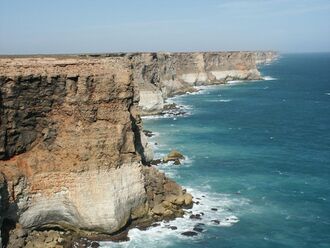Earth:Bight (geography)

In geography, a bight (/baɪt/) is a concave bend or curvature in a coastline, river or other geographical feature,[1] or it may refer to a very open bay formed by such a feature.[2] Such bays are typically broad, open, shallow and only slightly recessed.[3]
Description
Bights are distinguished from sounds, in that sounds are much deeper. Traditionally, explorers defined a bight as a bay that could be sailed out of on a single tack in a square-rigged sailing vessel, regardless of the direction of the wind[citation needed] (typically meaning the apex of the bight is less than 25 degrees from the edges).
The term is derived from Old English byht ("bend, angle, corner; bay, bight") with German Bucht and Danish bugt as cognates, both meaning "bay". Bight is not etymologically related to "bite" (Old English bītan).
Notable examples
- Bay of Campeche
- Bay of Plenty
- Bight of Benin
- Bight of Biafra or Bight of Bonny
- Canterbury Bight
- German Bight or Heligoland Bight
- Great Australian Bight
- McKenzie Bight
- Mecklenburg Bight
- Mid-Atlantic Bight
- New York Bight
- North Taranaki Bight
- Robson Bight
- Santa Monica Bay
- South Taranaki Bight
- Southern Bight
- Southern California Bight
- Trinity Bight, Newfoundland and Labrador
References
- ↑ "Definition of bight in English". Oxford University Press. http://www.oxforddictionaries.com/definition/english/bight.
- ↑ "bight". Merriam-Webster. https://www.merriam-webster.com/dictionary/bight.
- ↑ "What is a bight?". National Oceanic and Atmospheric Administration. http://oceanservice.noaa.gov/facts/bight.html.
id:teluk
 |


